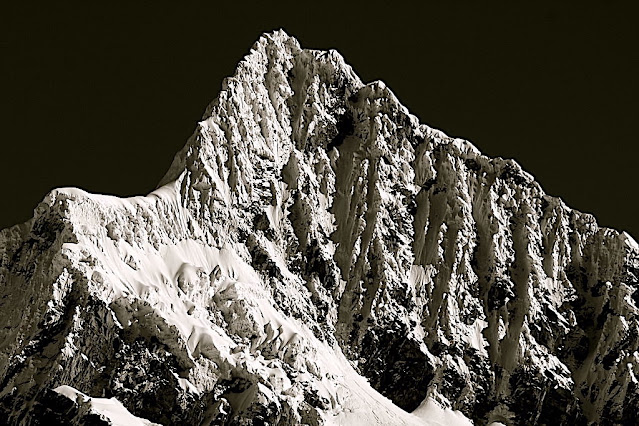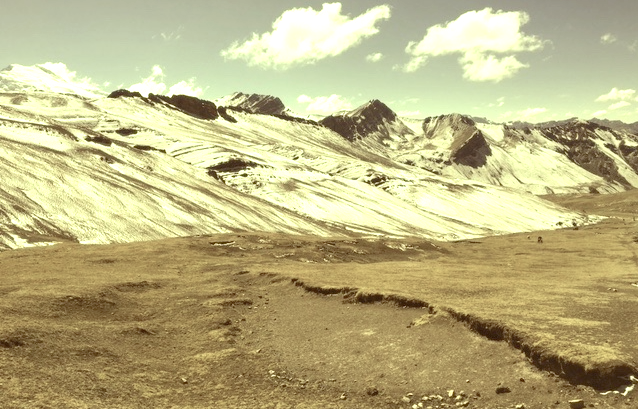%20Peru%20--%20Machu%20Picchu,%20Morning%20Light%20(1957)%20Oil%20on%20canvas,%2061%20x%2045.7%20cm.%20The%20Art%20Institute%20of%20Chicago%20(Rosenbaum%20Bequest.jpg)
Mont Machu Picchu (2 430m)
Pérou
In Machu Picchu, Morning Light (1957) Huile sur toile, 61 x 45.7 cm. The Art Institute of Chicago (Donation Rosenbaum)
Le site
Machu Picchu (2430m) du quechua machu pikchu, litt. « vieux sommet », est une ancienne cité inca du xve siècle au Pérou, perchée sur un promontoire rocheux qui unit les monts Machu Picchu et Huayna Picchu (« le Jeune Pic » en quechua) sur le versant oriental des Andes centrales. Son nom aurait été Pikchu ou Picho. Considérée comme une œuvre maîtresse de l'architecture inca , elle est peu à peu abandonnée après l'effondrement de l'Empire inca au XVIe siècle, puis méconnue durant des siècles en dehors de la population locale. Cela lui a conféré une réputation de « cité oubliée ». Machu Picchu fut explorée en 1911 par l'archéologue américain Hiram Bingham (1875-1956), professeur assistant d'histoire de l'Amérique latine à l'université Yale, qui la fit connaître dans un ouvrage de référence. Le site est généralement considéré comme une des résidences de l'empereur inca Pachacútec. Quelques-unes des plus grandes constructions et le caractère cérémonial de la principale voie d'accès au llaqta évoquent un sanctuaire religieux. En revanche, les experts ont écarté l'idée d'un ouvrage militaire. Au centre d'un ensemble culturel et naturel connu sous le nom de « Sanctuaire historique de Machu Picchu », le site est depuis 1983 sur la liste du patrimoine mondial de l'UNESCO et depuis le XXIe siècle une des destinations touristiques les plus visitées de la planète, suscitant des mesures de régulation du surtourisme.
La peintre
Georgia O’Keeffe est une peintre américaine considérée comme une des peintres modernistes et des précisionnistes majeures du xxe siècle. L'art de Georgia O'Keeffe, un temps considéré moderniste et d'avant-garde, est basé sur une observation minutieuse de la nature et sur sa volonté de peindre ce qu'elle ressent. Elle demeurera à l'écart des courants, suivant sa propre voie. Ses gros plans de fleurs, qui caractérisent une bonne partie de sa production, révèlent son sens aigu de l'observation. Le format de ses toiles, les couleurs et les nuances rendent ses tableaux pratiquement abstraits. Les paysages du Nouveau-Mexique lui offrent de nouveaux sujets. Ses toiles représentant des crânes d'animaux, peints minutieusement, cherchent à symboliser la beauté du désert. Ses nombreux voyages en avion durant les années 1950 et 1960 lui inspirent sa série sur les nuages avec des toiles souvent de grandes dimensions.
À sa mort, Georgia O'Keeffe laisse environ 900 tableaux.
En novembre 2014, la vente aux enchères du tableau « Jimson Weed/White Flower No. 1 » en salle des ventes à New York, estimé initialement à 15 millions de dollars, monte à 44,4 millions de dollars, établissant par la même occasion un nouveau record mondial lors d'une vente aux enchères pour une artiste féminine.Le Georgia O'Keeffe Museum, un musée consacré à l'artiste, a été
inauguré en 1997, à Santa Fe, grâce aux avoirs légués à sa mort. Sa
maison à Abiquiú a été déclarée National Historic Landmark en 1998. Un
film inspiré de son mariage a été réalisé par Edwin Sherin en 1991, A Marriage: Georgia O'Keeffe and Alfred Stieglitz.
Un film biographique de Bob Balaban, Georgia O'Keeffe, est paru en
2009. Ses œuvres font partie des collections de nombreuses institutions
muséales.
______________________________
2024 - Gravir les montagnes en peinture
Un blog de Francis Rousseau






















